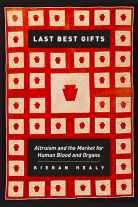Last Best Gifts
 My new book, Last Best Gifts: Altruism and the Market for Human Blood and Organs has just been published by the University of Chicago Press. You can buy it from Amazon, Barnes & Noble, Powells or of course any bookseller worth the name. There’s a website for the book, too. Amongst other things, there you can learn more about the cover image, which the people at Chicago did such a nice job with after I came across it by chance.
My new book, Last Best Gifts: Altruism and the Market for Human Blood and Organs has just been published by the University of Chicago Press. You can buy it from Amazon, Barnes & Noble, Powells or of course any bookseller worth the name. There’s a website for the book, too. Amongst other things, there you can learn more about the cover image, which the people at Chicago did such a nice job with after I came across it by chance.
The book is a study of the social organization of exchange in human blood and organs. In a nutshell, it tries to show that gift exchange can do both more and less than we think when it comes to organizing the blood and organ supply: more, because there’s a lot of heterogeneity in actually-existing systems of donation. Some countries and regions do much better than others, and, in many cases (especially cadaveric donation), market incentives would probably not work any better. But also less, because gift exchange is not some magical mechanism for generating social solidarity out of thin air, especially in a procurement system that is increasingly rationalized and globalized. The book argues that the consequences of rationalizing the blood and organ supply are in many ways more important than the consequences of commodifying it. In particular, the logistical demands of procurement systems—short-run, nuts-and-bolts stuff about finding bodies and procuring organs—are in tension with the public account of donation as a sacred gift of life.
I’d like to think that the book has something new to contribute to the ongoing debate about commodifying human blood, organs and tissues. And I’d like to think that it’s written in an accessible and engaging way. And while I’m waiting for UPS to deliver my pony, I’d like you all to go and buy it, not just for yourself, but for your friends, and for the sake of this small kitten beside me. You wouldn’t want anything bad to happen to the kitten, would you?